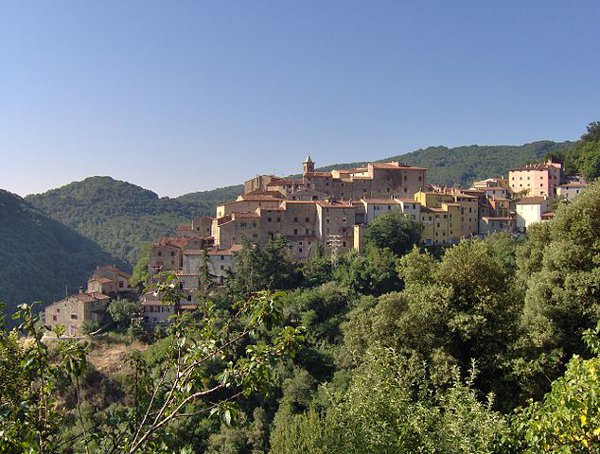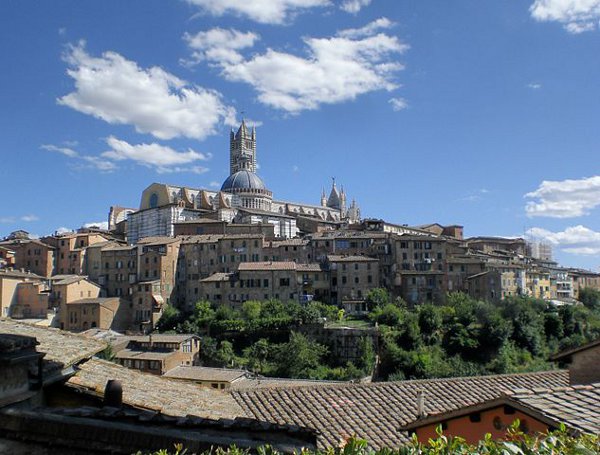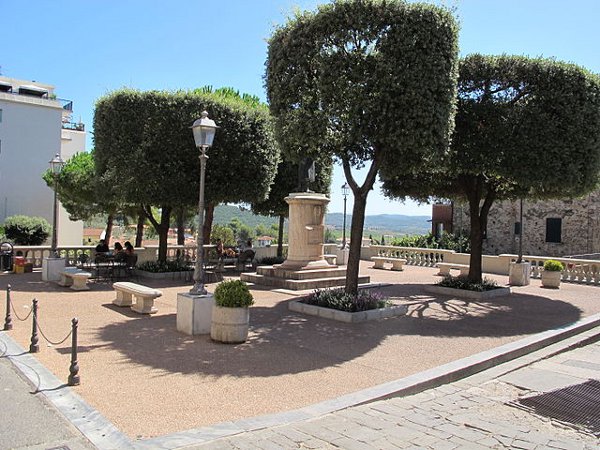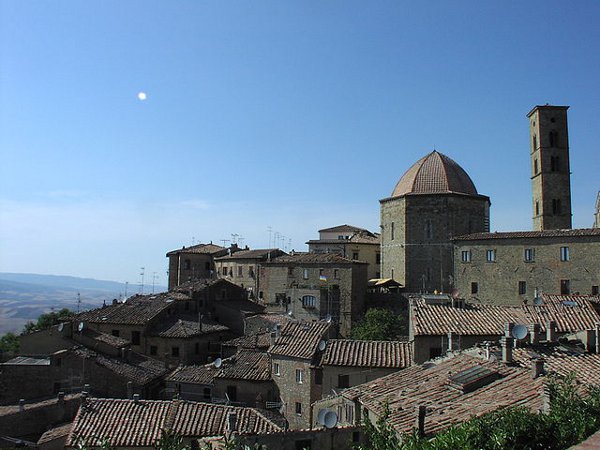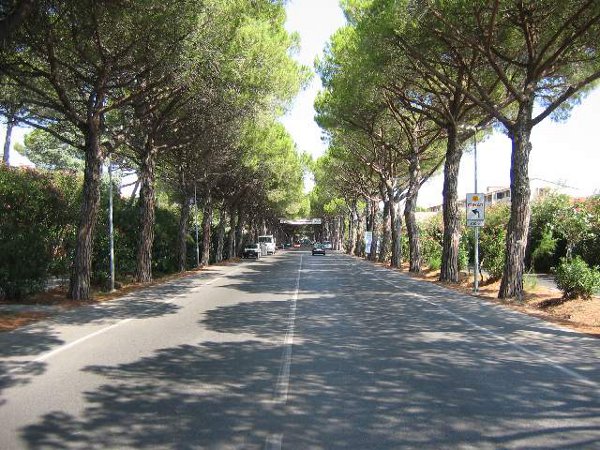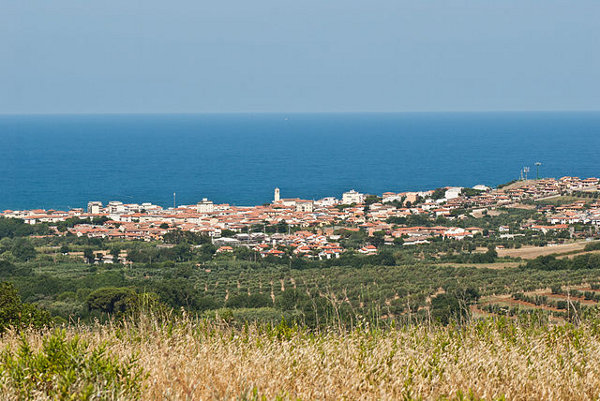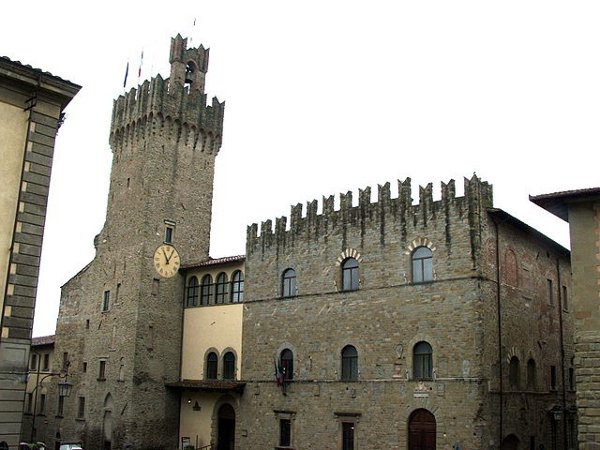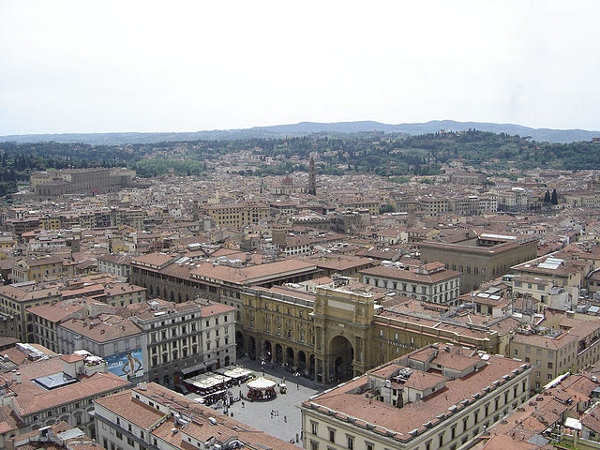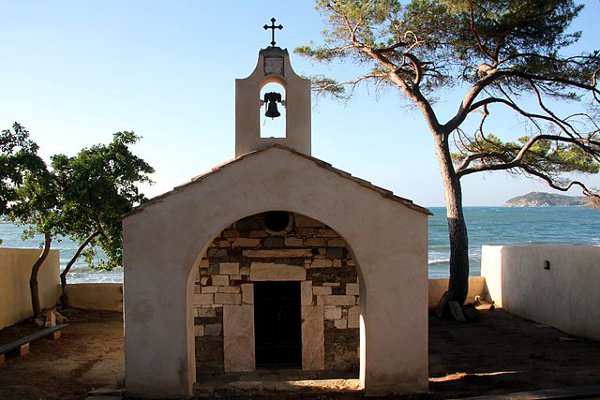Important tourist center famous for the "Giostra del Saracino" (jousting tournament that is held on the first Sunday of September each year) and for a major antiques fair (the first Sunday of each month). The Gothic cathedral, the monumental Piazza Grande, with the majestic Palace of the lodges by Giorgio Vasari, the Vasari same house beautifully frescoed, the birthplace of Francesco Petrarca, Palazzo dei Priori, the church of S. Maria delle Grazie and San Domenico (sec XIII - XIV), which preserves a valuable altar crucifix by Cimabue are just some of the works that give luster to this town with the famous church of San Francesco in which we find an impressive and prestigious cycle of frescoes of the "Legend of the True Cross" by Piero della Francesca: one of the greatest achievements of all the 400 and the scenic Pieve S. Maria, one of the most important Romanesque buildings in the region. Among the many fine museums include the "Medieval and Modern" and the Archaeological Museum with prehistoric, Roman and Etruscan mainly located at the remains of the Roman amphitheater.
Arezzo, m. 296 on a mild slope of the northern edge of the Val di Chiana where this is grafted with Casentino, Valdarno, with the wide grooves of the Arno, one to the east, the other west, the Apennine ridge Pratomagno (1592 m).
The city's population is 108,000, which .. The inner city expands, wrapping a hillside on which it stands, with a plant almost semicircular, whose center is occupied by the Cathedral, which is situated in a dominant position, 286 meters. From the Piazza del Duomo depart radially the three main streets of the city on their way to the Val di Chiana, the Valdarno di Sopra, in the Casentino. Via Garibaldi size, the three major main roads, following the axis of the semi-circle. Outside of it, towards the railway line, there are less ancient neighborhoods, with streets, straight, wide, tree-lined, which refer to the large square in the center of which stands the monument to Guido Monaco erected in 1981 to mark the centenary of the great Arezzo.
A characteristic feature, keep the streets of the medieval Old Town and the cobbled streets lined with buildings in the sixteenth century. Noteworthy is the Cathedral, whose facade is modern renovation, in harmony with the interior architecture, with three naves of Roman-Gothic style, beautiful and hexagonal, also modern and rich in the works of painting and writing. Notable Santa Maria della Pieve with its portals, the work of the thirteenth century, with a high tower campacaria. Fine the churches of S. Francesco (XIII century restored between 1900 and 1920) with the frescoes of Piero della Francesca and St. Dominic (XIII; later restored), built on the design of the Annunciation Nicola Pisano (1491-1517) by Antonio Sangallo, and the Santa Maria delle Grazie (XV) attributed to Benedetto da Majano with its elegant portico, which is reminiscent of the Servants, in Bologna, as well as the Loggia del Vasari.
Arezzo is a city in Tuscany capital of the province, in m. 296 on a mild slope of the northern edge of the Val di Chiana where this is grafted with Casentino, Valdarno, with the wide grooves of the Arno, one to the east, the other west, the Apennine ridge Pratomagno (1592 m).
The city's population is 108,000, which .. The inner city expands, wrapping a hillside on which it stands, with a plant almost semicircular, whose center is occupied by the Cathedral, which is situated in a dominant position, 286 meters. From the Piazza del Duomo depart radially the three main streets of the city on their way to the Val di Chiana, the Valdarno di Sopra, in the Casentino. Via Garibaldi size, the three major main roads, following the axis of the semi-circle. Outside of it, towards the railway line, there are less ancient neighborhoods, with streets, straight, wide, tree-lined, which refer to the large square in the center of which stands the monument to Guido Monaco erected in 1981 to mark the centenary of the great Arezzo.
A characteristic feature, retain the streets of the medieval Old Town and the cobbled streets lined with buildings in the sixteenth century. Noteworthy is the Cathedral, whose facade is modern renovation, in harmony with the interior architecture, with three naves of Roman-Gothic style, beautiful and hexagonal, also modern and rich in the works of painting and writing. Notable Santa Maria della Pieve with its portals, the work of the thirteenth century, with a high tower campacaria. Fine the churches of S. Francesco (XIII century restored between 1900 and 1920) with the frescoes of Piero della Francesca and St. Dominic (XIII; later restored), built on the design of the Annunciation Nicola Pisano (1491-1517) by Antonio Sangallo, and the Santa Maria delle Grazie (XV) attributed to Benedetto da Majano with its elegant portico, which is reminiscent of the Servants, in Bologna, as well as the Loggia del Vasari.
Archaeological Etruscan document the existence of Arezzo (Arretium) since the sixth century. BC The city continued to flourish during the Roman period, when it was organized as a town hall with a vast territory.
In the first imperial period its sealed ceramic red coral with relief decoration (ceramic Arezzo) became famous and was exported and then imitated throughout the territory of the Empire. It was famous as much as they are now its industries goldsmith who, along with businesses of various types of Arezzo are one of the richest cities in Italy. The classical period the Archaeological Museum provides rich testimony: his most famous piece is probably the crater of Euphronios 500 BC
Rich and intense was the life of the city in the Middle Ages. We remember only one episode: the clash with Florence Campaldino in 1289 that reminds us of famous verses of Dante Alighieri. Traces the exile Florentine poet is full of rest and the nearby beautiful Casentino valley, one of four in the Arezzo area with Valdarno, Val di Chiana and the Tiber Valley. In 1384 Arezzo was practically "sold" in Florence and from then on his story was that of the Florentine Republic before the Signoria and the Grand Duchy of Tuscany then. Physicians naturally left their mark in the sixteenth-century fortress in the north of the city. In the historical center, who walks along the Corso or the narrow medieval streets that lead up to the highest part where the Gothic cathedral dedicated to San Donato, often has the impression of being inside one of the frescoes of Piero della Francesca's Legend of the True Cross, in St. Francis. In the background of the discovery of the three Crosses, Jerusalem has the traits real dell'Arezzo fifteenth. The Romanesque period the capolacvoro is the church of Santa Maria dei sec. XII and XIII, of great beauty, which contains, amongst other works of art a polyptych by Pietro Lorenzetti. In the Church of San Domenico then there is another exceptional piece, a Crucifix by Cimabue.
In this town was the birthplace of Francesco Petrarch and, a few centuries later, Giorgio Vasari, famous for his Lives, still indispensable text for the biography of the artists until the sixteenth century.
In Arezzo still runs every year the Giostra del Saracino, a traditional festival in costume. With the spear skilled knights on horseback attack the wooden figure of the "tumbler" which in turn can affect horse and rider with a weapon he holds in his right hand if that, once hit, does not go away quickly.
Arezzo: The birth of the free Commune
It is the rebirth after the Mille to trigger a new ferment economic, demographic and housing. Hinge and emblem of the recovery is the birth of the free Commune, which rapidly extends its dominance in the countryside, eroding the noble powers of the ecclesiastical authorities. The presence of a console is attested in Arezzo since 1098.
Around 1200 urban development leads to the construction of a new circle of walls, which on the NE side reconnects to the Etruscan-Roman times, while on the slopes S 0 and embraces a semi-circle the base of the hill with a clipping path still visible in the street Garibaldi (15 Kb). I1 perimeter of the city reaches 2,600 m. and encloses an area of approx. 51 hectares, the main radial village becomes the master. In the course of the thirteenth century are situated at the top of the hill numerous public buildings and casetorre (36 Kb) is completed the construction of the first great basilica of the town hall, the church of S. Maria, a splendid example of Romanesque architecture (14 Kb). At the end of the century, under the influence of the new gothic style which is emerging: the construction of the Cathedral, an event that follows the forced return of the bishopric within the walls (1203), and the churches of two major monastic orders preachers : S. Francis and St. Domenico.
The city life is regulated by the city, governed mainly by the Ghibellines, which extends its control over a vast territory (from Borgo San Sepolcro to Massa Trabaria, mid Valdambra the Valdarno, Casentino from the Chiana Valley) being protagonist of the bloody seizure of Cortona (1258) (11 Kb) and clashing with varying degrees of success with large nearby towns (Siena, Florence, Perugia, Città di Castello).
The defeat suffered by the Ghibellines in Campaldino (1289), where he died the same Guglielmino Ubertini bishop of Arezzo, Florence and Siena puts in possession of large portions of the territory of Arezzo.
The cultural revival includes the opening of the Studium - whose legal systems governing in 1255 one of the oldest medieval universities - the flowering of liberal arts and the business of poets (Guittone, 1235 ca. - 1294) and artists (Margarito d ' Arezzo, 1236 ca. - 1293 approx.), followed by Florentine masters (Cimabue, Crucifix in S. Domenico) and Siena (Pietro Lorenzetti, polyptych of the Parish). In 1304 Arezzo gives birth to Francesco Petrarca, the son of a Florentine escaped.
Arezzo: The Lordship of Tarlati
The Rise of Guido Tarlati (bishop in 1312, in 1321 lord for life), home of the powerful Ghibelline Pietramala (his coat of arms is kept at the Coat of Arms of the State (28 Kb), while his cenotaph is located in Cathedral (25 Kb), lifts the city from the defeat of Campaldino and starts in the first decades of the fourteenth century a new, intense period of development.
In the wake of re-conquests and territorial expansion will proceed to a further widening of the walls towards the plains of the south; work is completed, the civic walls enclose an area of 107 hectares.
A Guido Tarlati happens in the lordship his brother Pier Saccone (1327), with whom he began a rapid process of decay, in 1337 the city was sold for the first time in Florence, which brought to power the Guelph party.
Recovered their independence and failed several attempts to establish a government mansion, we arrive between 1376 and 1384 to a prolonged political crisis, during which the city is repeatedly sacked. In the same 1384, was sold again in Florence from Enguerrand de Coucy leader for 40 thousand gold florins and definitively tied to the fate of the dominant, Arezzo lost, along with independence, much of its cultural and artistic autonomy.
Spinello Aretino (1346 ca. 1410) is the latest local artist to work in the city in the second half of the fourteenth century, in the course of the next century the cultural environment Arezzo is dominated by the personality of training in Florence, which leave a clear imprint even in ' architecture town, in the transition from the Gothic to the Renaissance.
In the fifteenth century operate in Arezzo Bernardo Rossellini (Palace of the Fraternity), Benedetto da Majano (portico of S. Maria delle Grazie), Giuliano da Majano (cloister of the Badia), Parri di Spinello, Bartolomeo della Gatta (a project of the Church of the Annunciation ).
But the event of greatest flow rate is the assignment of Piero della Francesca frescoes in the choir of the church of S. Francis, from office, awarded in 1453, was born the famous cycle of the Legend of the True Cross, which was to come into the category of masterpieces of Italian art and universal. They come from Arezzo, however, men like the humanist Leonardo Bruni (35 Kb) (1374 approx. -1444), Author of the Historia Florentina, writers Benedict (13 Kb) (1415 -1466), Francesco (1416-1488) and Bernardo ( 1458 1535) Welcomed the corrosive writer Pietro Aretino (1492-1556).
Small tips for finding their own solutions for holidays in Tuscany.
Those who approach the idea of spending his holidays on the Tuscan coast will need to consult a guide coast hotels Tuscany to find hotels on the Tuscan coast or hotel on the Tuscan Riviera.
The Italianists prefer to look for hotels or hotels on the Tuscan coast in Tuscany.
It should however be considered that the Etruscan Coast is in fact in Maremma
(Remember that reaches up to the Maremma Livorno), then refer to the guide in the Tuscan coast hotels will be well oriented to the voice holidays in Maremma and search for hotels in the fen or, if you prefer, hotels in the fen.
Given that in recent years tourism has largely shown a preference for solutions besides housing type hotel, residences in Tuscany, holiday apartment in Tuscany, holiday apartments on the Costa Tuscan vacation homes for rent have become frequent items search of help texts Tuscan tourism or tourism guide the Tuscan coast.
The search for residence on the Tuscan Coast could be profitable since the topic is more general in apartments for rent, holiday Tuscan sea, sailing holiday, summer holidays Tuscany.
It is not to be neglected even the search for rooms Tuscany, basically we are talking about Tuscany Italy, holiday apartment Tuscany, someone with more economic means looking Tuscan villa or villa rentals Tuscany Tuscan coast.
For those who opted for a specific area such as the Etruscan coast or to Castiglioncello in a particular way, it will be well to remember that the search terms to be extended to Castiglioncello holiday besides vacation rental Tuscany Tuscany beach or camping or even Tuscany.
Then there is the chapter of the holiday apartment very popular among couples and even by couples with a baby. Studios for rent Tuscany is therefore a search term very profitable, as well as studios or studio accommodation Tuscany Coast Tuscany.
For those in search of the substance and a room can be enough rooms or rooms holiday accommodation Tuscany Coast Tuscany or even rooms for rent Tuscany should be appropriate search terms as well as rooms Tuscany.
Last but not least, we must remember 's Farm or Farm Holidays Tuscany Tuscany.
It is also for this second chapter as previously said about the Maremma, then checking the Tuscan coast hotels guide or even sleep in Tuscany where the need to search for or type the entries residence in Maremma, Maremma apartments, hotels or hotels in Maremma in the fen.
https://tuscanysea.com/backoffice/immagini/tuscanysea.com/9-17-5-2013-10-17-421.jpg
https://tuscanysea.com/backoffice/immagini/tuscanysea.com/9-17-5-2013-10-17-422.jpg

